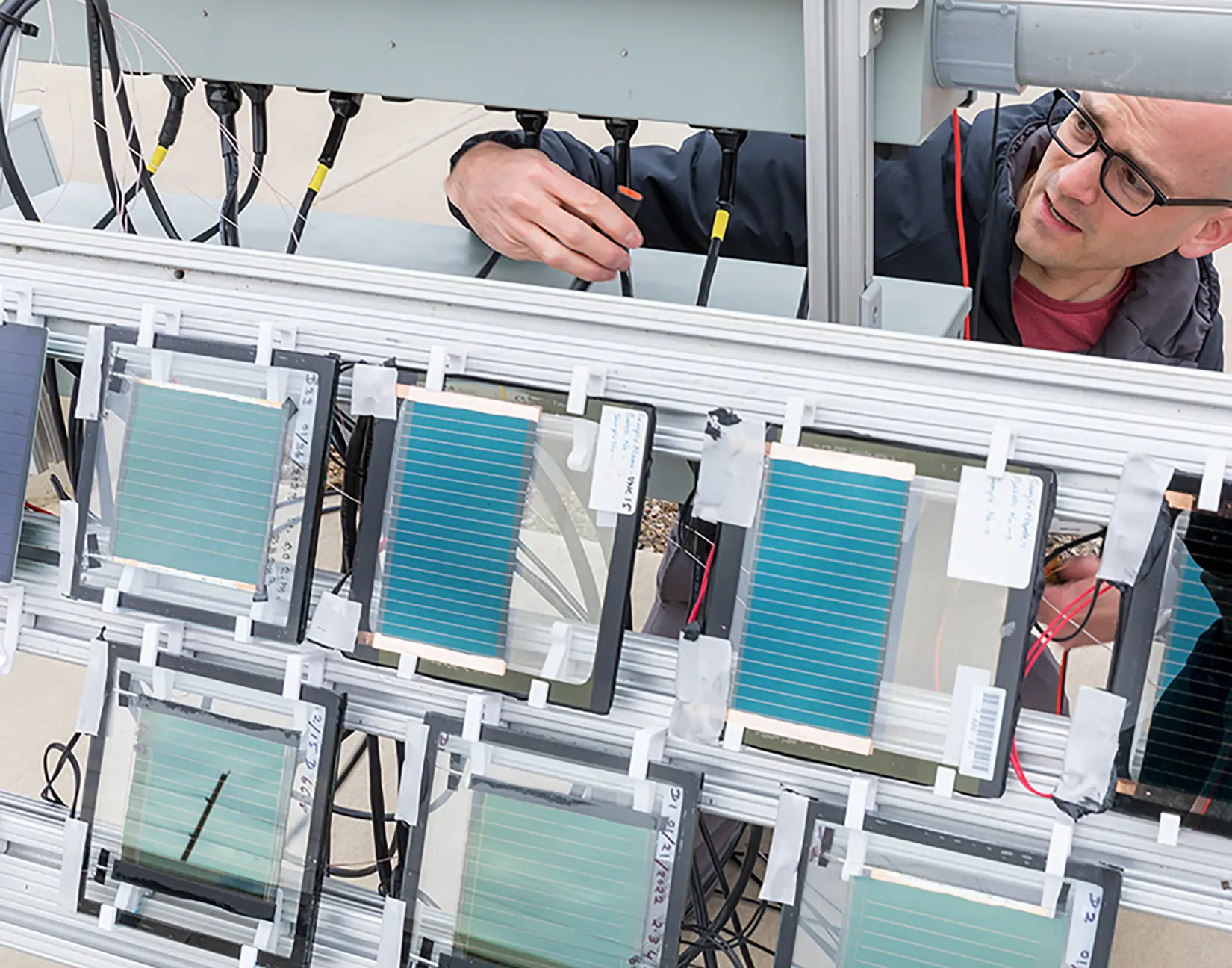Perovskite Experts at NREL, Sandia Push for Outdoor Tests To Validate Durability of Emerging Solar Technology

NREL researchers are recommending investigating the durability of perovskite solar modules—starting by putting them outside.
The recommendations outlined in a think piece recently published in the journal Nature Energy provide a shift in focus in research to consider more than the efficiency of perovskites. The class of materials described as perovskites has proven highly efficient at harnessing sunlight for conversion into electricity, but the commercialization of the technology has lagged while work continues on durability issues.
“We aren’t going to say that the efficiency is fully solved, but it’s been proven to a point that focus can shift,” said Laura Schelhas, a senior scientist at NREL and co-author of the paper, “Durability Research Is Pivotal for Perovskite Photovoltaics.” “There’s still value in pursuing efficiency and fundamentals, but we need more people to start to pivot to the reliability focus and getting things outside and tests that are relevant to a real-world operation.”
Schelhas serves as deputy director of the Photovoltaic Accelerator for Commercializing Technologies (PACT) Center, which is conducting outdoor testing of perovskite modules at NREL in Colorado and at Sandia National Laboratories in New Mexico. The PACT Center has tested about 650 perovskite modules in the past five years.
“This paper implores the perovskite PV community to put more weight on durability,” said Tim Silverman, a senior scientist at NREL and a co-author of the article. The other co-authors are Michael Deceglie, Ingrid Repins, Michael Owen-Bellini, and Joseph Berry from NREL, and Joshua Stein from Sandia. “We can’t make energy with just efficiency. We also have to have devices that last a long time outdoors.”
Silverman said researchers should “follow a familiar cycle in durability research.” That is, put the module outside in the elements that can affect durability—light, heat, humidity, rain, wind, snow, hail, and whatever else nature throws at it—and leave it there until it breaks. The focus then shifts into determining why a module broke, develop tests to hit the breaking point sooner, and try again.
“The community has rarely taken the first step,” he said, “so we do not have very long-lasting devices yet in field testing.”
Modules made of silicon are the most deployed solar technology and typically are guaranteed to last for decades thanks to extensive testing and years of field data. Because perovskite modules are relatively new, data is lacking in how long they can be expected to function.
Existing stress tests can show how well a perovskite module will function upon exposure to certain conditions but offer no guarantees to durability in the field.
“I do this one test for 1,000 hours and that’s going to tell me that it’s going to live for 35 years?” Schelhas said. “No. I’m sorry. It doesn’t work that way.”
The NREL-led team offered these recommendations:
- Field test modules as early as possible so that a longer duration of service data can be observed.
- Conduct carefully controlled indoor measurements before and after field exposures and accelerated test exposures.
- Analyze what went wrong when modules fail—either in the field or in accelerated testing—and make a change to the materials, design, or fabrication of new modules.
While silicon dominates the solar field, the opportunity remains for new technologies such as perovskites. Perovskites hold the potential of creating a more diversified domestic PV manufacturing industry. While silicon-based solar modules currently rely significantly on imported materials, perovskite modules are created by depositing a thin mixture of chemicals on top of a glass substrate, requiring fewer—if any—imported materials.
“The thing we’re most excited about in perovskites is it does start to provide that secure, cost-competitive potential for the U.S.,” Schelhas said. “This work can be done in factories in the U.S. using technology that we have access to, which creates jobs and energy security.”
The forward momentum of the perovskite industry would benefit from a concerted community effort among companies, academics, and other institutional researchers, according to the journal article. The authors noted: “Prioritizing durability research and finding effective means for sharing key lessons and information throughout the community will ensure rapid progress and deployment.”
The research at NREL and Sandia, which are two of the 17 U.S. Department of Energy laboratories, was funded by the department’s Solar Energy Technologies Office.
Learn more about NREL’s research into perovskite solar cells.
Last Updated May 28, 2025
